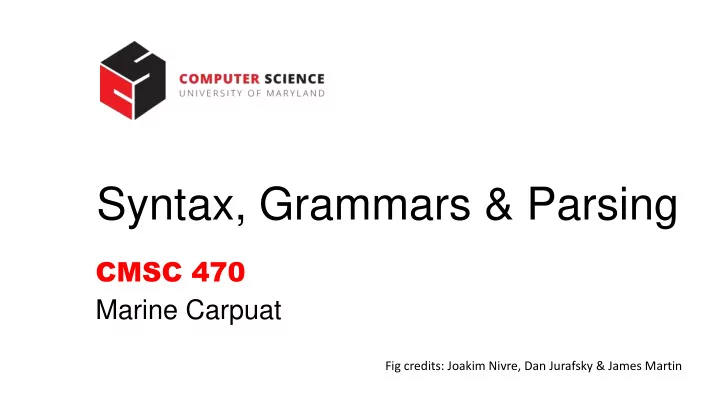

Syntax, Grammars & Parsing CMSC 470 Marine Carpuat Fig credits: Joakim Nivre, Dan Jurafsky & James Martin
Syntax & Grammar • Syntax • From Greek syntaxis, meaning “setting out together” • refers to the way words are arranged together. • Grammar • Set of structural rules governing composition of clauses, phrases, and words in any given natural language • Descriptive, not prescriptive • Panini’s grammar of Sanskrit ~2000 years ago
Syntax and Grammar • Goal of syntactic theory • “explain how people combine words to form sentences and how children attain knowledge of sentence structure” • Grammar • implicit knowledge of a native speaker • acquired without explicit instruction • minimally able to generate all and only the possible sentences of the language [Philips, 2003]
Syntax in NLP • Syntactic analysis can be useful in many NLP applications • Grammar checkers • Dialogue systems • Question answering • Information extraction • Machine translation • … • Sequence models can go a long way but syntactic analysis is particularly useful • In low resource settings • In tasks where precise output structure matters
Two views of syntactic structure • Constituency (phrase structure) • Phrase structure organizes words in nested constituents • Dependency structure • Shows which words depend on (modify or are arguments of) which on other words
Constituency • Basic idea: groups of words act as a single unit • Constituents form coherent classes that behave similarly • With respect to their internal structure: e.g., at the core of a noun phrase is a noun • With respect to other constituents: e.g., noun phrases generally occur before verbs
Constituency: Example • The following are all noun phrases in English... • Why? • They can all precede verbs • They can all be preposed/postposed • …
Grammars and Constituency • For a particular language: • What are the “right” set of constituents? • What rules govern how they combine? • Answer: not obvious and difficult • There are many different theories of grammar and competing analyses of the same data!
An Example Context-Free Grammar
Parse Tree: Example Note: equivalence between parse trees and bracket notation
Dependency Grammars • Context-Free Grammars focus on constituents • Non- terminals don’t actually appear in the sentence • In dependency grammar, a parse is a graph (usually a tree) where: • Nodes represent words • Edges represent dependency relations between words (typed or untyped, directed or undirected)
Example Dependency Parse They hid the letter on the shelf Compare with constituent parse… What’s the relation ?
Dependency Grammars • Syntactic structure = lexical items linked by binary asymmetrical relations called dependencies
Example Dependency Parse Dependencies form a tree: - Connected - Acyclic - Single-head They hid the letter on the shelf Compare with constituent parse… What’s the relation ?
Dependency Relations
Universal Dependencies project • Set of dependency relations that are • Linguistically motivated • Computationally useful • Cross-linguistically applicable • [Nivre et al. 2016] • Universaldependencies.org
Outline • Syntax & Grammar • Two views of syntactic structures • Context-Free Grammars • Dependency grammars • Can be used to capture various facts about the structure of language (but not all!) • Dependency Parsing
Data-driven dependency parsing Goal: learn a good predictor of dependency graphs Input: sentence Output: dependency graph/tree G = (V,A) Can be framed as a structured prediction task - very large output space - with interdependent labels 2 dominant approaches: transition-based parsing and graph-based parsing
Transition-based dependency parsing • Builds on shift-reduce parsing [Aho & Ullman, 1972] • Configuration • Stack • Input buffer of words • Set of dependency relations • Goal of parsing • find a final configuration where • all words accounted for • Relations form dependency tree
Defining Transitions • Transitions • Are functions that produce a new configuration given current configuration • Parsing is the task of finding a sequence of transition that leads from start state to desired goal state • Start state • Stack initialized with ROOT node • Input buffer initialized with words in sentence • Dependency relation set = empty • End state • Stack and word lists are empty • Set of dependency relations = final parse
Arc Standard Transition System defines 3 transition operators [Covington, 2001; Nivre 2003] LEFT-ARC • create head-dependent relation between word at top of stack and 2 nd word (under top) • remove 2 nd word from stack RIGHT-ARC • Create head-dependent relation between word on 2 nd word on stack and word on top • Remove word at top of stack SHIFT • Remove word at head of input buffer • Push it on the stack
Arc standard transition systems • Preconditions • ROOT cannot have incoming arcs • LEFT-ARC cannot be applied when ROOT is the 2 nd element in stack • LEFT-ARC and RIGHT-ARC require 2 elements in stack to be applied
Transition-based Dependency Parser Properties of this algorithm: - Linear in sentence length - A greedy algorithm - Output quality depends on oracle
Let’s parse this sentence
Transition-Based Parsing Illustrated
Outline • Syntax & Grammar • Two views of syntactic structures • Context-Free Grammars • Dependency grammars • Can be used to capture various facts about the structure of language (but not all!) • Dependency Parsing • Transition-based parser
Where do we get an oracle? • Multiclass classification problem • Input: current parsing state (e.g., current and previous configurations) • Output: one transition among all possible transitions • Q: size of output space? • Supervised classifiers can be used • E.g., perceptron • Open questions • What are good features for this task? • Where do we get training examples?
Recommend
More recommend